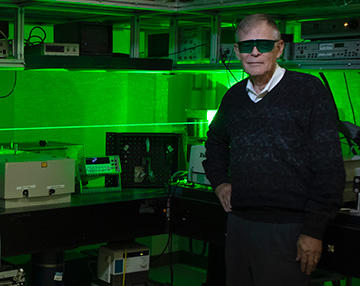
Robert L. Byer. [Image: Stanford University]
For its May 2020 print article “The Laser at 60,” OPN interviewed a range of OSA Fellows to get their insights on some particularly interesting horizons in laser research today. We’re presenting a selection of those interviews online. Below is an edited version of our interview with Robert Byer of Stanford University, USA.
Byer published his first laser paper only a few years after the device’s initial demonstration by Theodore Maiman on 16 May 1960—and hasn’t stopped expanding the frontiers since then. He now co-leads the Accelerator on a Chip (ACHIP) program, which seeks to use lasers as the engines to create new, ultra-compact approaches to particle acceleration—work that could help spur a new generation of tabletop X-ray free-electron lasers.
You’ve seen and helped make a lot of the history in laser development over the past six decades. What you view as the most interesting and potentially productive questions in laser science that are being addressed today? Where are the biggest strides going to be made?
Well, the frontiers are many-fold, but the ones that have got our attention at Stanford right now are X-ray coherent sources, or X-ray lasers. It’s now 10 years since SLAC built the first coherent X-ray free electron laser, and now they’re building version two, and there are half a dozen X-ray lasers around the world.
What do these lasers provide?
With that shorter wavelength comes whole new ways to explore chemistry, biology, physics at the hard X-ray spectral range. But also with that come attosecond pulsed sources. The word attosecond has been used for most of the last decade, but true attosecond light pulses really need to be coherent in the X-ray spectral range.
And you also have a new tool that allows you to do your time-resolved diffraction, time-resolved chemical-bond makeup. So, it opens up a new window for understanding what’s really going on in detail at the atomic level and subatomic level.
Are there specific applications that are driving research into coherent X-ray sources?
It’s overwhelming on how many applications there are in the X-ray spectral range. Synchrotron radiation sources have existed for the last 20 years, and they opened the gate to doing spectroscopy and materials science and biology in the X-ray spectral range. But those are incoherent X-rays, with much smaller peak powers and much longer pulse lengths—typically picoseconds or longer.
Coherent X-ray sources are now operating, but they’re oversubscribed by a lot—that’s why there have been national labs building more of them. But the trend will be toward smaller machines, and eventually tabletop X-ray lasers is, I think, realistic to expect in the coming decade.
You’ve been involved in recent work regarding laser-driven on-chip particle accelerators, which I heard was something that could actually contribute to these tabletop X-ray free-electron lasers. Could you talk about that work?
That’s right. The program got its start way back in 1974, when I was on sabbatical leave in Lund, Sweden, but we didn’t actually do experiments until we started in 1996 with the Stanford Linear Accelerator Center (SLAC). And we did our first experimental phase eight years later, in 2004, and published the first significant acceleration of electrons in November 2013, when we had an article in Nature magazine. Simultaneously, on the same day, in Physical Review Letters, our colleagues in Germany, Peter Hommelhoff and his group, published the laser acceleration of electrons as well.
That program, unfortunately, got canceled shortly thereafter. It was a DARPA-funded program, and DARPA wanted the impossible. We said we couldn’t deliver the impossible—we can do almost that, but not quite. But the Moore Foundation picked up on it. They wanted to fund high-risk, high-payoff research. We explained that accelerator science research was really high risk, and they funded us.
We created an international team. The collaboration started with about 25 people; it’s now up to 75. And we have collaborators in Europe, collaborators in Japan and Taiwan and across the U.S. And it’s a very eclectic, fun working group that knows what the challenges are and set out to meet them.
What has ACHIP been doing recently, in the wake of the earlier achievement of accelerating electrons with lasers?
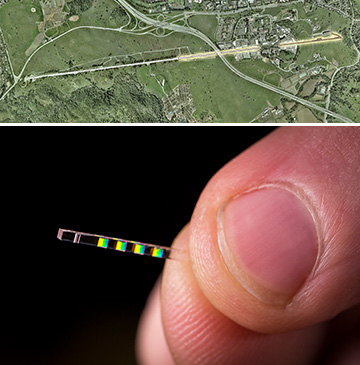
The ACHIP program, co-led by Byer, aims to reduce the kilometer-scale particle accelerators that drive X-ray free-electron lasers such as the Linac Coherent Light Source (LCLS, top) to laser-driven analogs that can fit on a silicon chip (bottom). [Images: SLAC Linear Accelerator Laboratory; ACHIP program]
Our recent end-of-the-year record was four publications in a week. We had two back-to-back publications in Physical Review Letters, in which we demonstrated bunched electrons in the accelerator to a 250-attosecond pulse duration. And we know that, as the accelerator gains energy, pulse durations can decline down to something approaching 10 attoseconds.
At the speed of light, one attosecond is equivalent to light travelling across a hydrogen molecule. That’s how short the pulses are. And so, the attosecond bunches of electrons will eventually gain enough energy in accelerator structures to drive a free-electron-type undulator radiator.
And that radiator is in the X-ray range. Since everything is small and has a high repetition rate, we can put a resonator around the X-ray source, and build a synchronously pumped X-ray laser on the tabletop that’s both spatially and spectrally coherent. Truly coherent radiation in the X-ray spectral range.
That’s a long way from Maiman’s tabletop laser, 60 years ago.
Yes. It will look and feel much like a laser felt in the early 1960s—when, as Art Schawlow quipped, the laser was “a solution looking for a problem.” Well, the solution found a set of problems that are global in extent. All of our communication today is based on lasers and optical fiber communications. Lasers have penetrated virtually all fields of science and medicine. So the 60 years have gone by pretty quickly.
Basically, all of this started with an idea that maybe it’s time for accelerators to do what lasers did 30 years ago. Lasers left the vacuum tube era—that’s what I grew up in. The argon-ion lasers and helium-neon lasers were all vacuum tubes. And then the lasers made the transition into solid state—well, it was almost from the beginning that semiconductor lasers existed, in 1962 or 1963. But they didn’t really become important until they were room temperature and small and compact. And now, of course, semiconductor lasers are in every modern cellphone that does facial recognition.
Accelerators never made that transition. Even today, accelerators are made the same way they were made in 1949. And so, we’re the first to try to make the transition away from vacuum tubes to all solid-state accelerators built on silicon and using modern fabrication tools and lithography, and using modern lasers that operate at high efficiency at very, very robust performance numbers.
With that combination, we think we will democratize accelerators. We’ll make them small enough and cheap enough and you can design them directly to meet your science need or manufacturing need, and begin to get accelerators much more widely used.
That’s quite a vision.
We’re lucky because the Moore Foundation has been a marvelous sponsor of this research. They not only gave us five years of time to meet our final goal, which is a one-million-electron-volt energy gain, and to demonstrate science with the accelerator compressed bunches. But they’ve now extended our program by a couple more years to let us focus on the applications of the accelerator on the chip—the physics and chemistry.
So we’re in seventh heaven. They verified that what we’ve been doing is valuable to them, and it looks like it’s going to meet the design goals that we’ve set for it.
As you look out more broadly at the laser community, what are some of the other frontiers for laser technology that look particularly interesting?
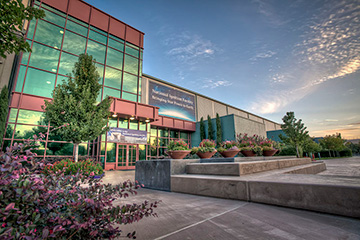
U.S. National Ignition Facility. [Image: LLNL/Wikimedia Commons]
One of them that’s not getting much attention now, but will by the end of the year because of a report that’s being written for Congress, is the National Ignition Facility (NIF) laser. NIF has now celebrated its 10th year of operation in August of last year. It has shot 4,000 shots; it’s had an up-rate of 95%-plus of requested shots it delivers. And it’s taken us from being marginal on how to generate a fusion energy process to the point where we’re generating enough neutrons in a fusion energy process to exceed the amount of energy it takes to compress the pellet.
So, a way to say that is we’re now at 2×1016 neutrons in 10 picoseconds. That number of neutrons turns about to be about 30 to 40 kilojoules of energy being released from the fusion reaction and the compressed pellet.
We are within a factor of two of going from the neighborhood of 100 kilojoules to a megajoule output energy by fusion burn. That is, if we had a laser twice the size of NIF—another laser like NIF, on the other side of the target chamber, for example—we would be burning fuel and generating megajoules of energy per shot. At that point, you’d need a bigger target chamber. You’d need time to let the apparatus cool off after generating so many neutrons.
In other words, you’re getting toward real nuclear energy. My best guess is that the NIF laser will be replicated elsewhere in the world in this decade, and it will be replicated using modern technology—diode pumps and neodymium glass technology that allows a 10-hertz repetition rate. And my guess is that it will be built at the scale that allows for efficient nuclear burn. That would be a big step forward in looking at potential energy sources to which we have no access today.
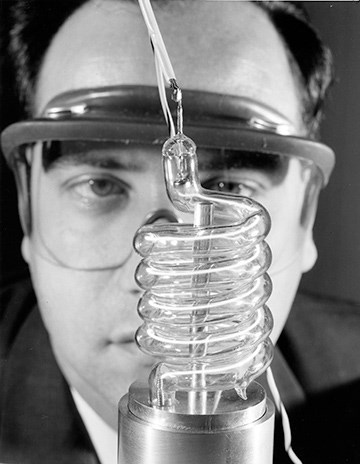
Theodore Maiman with first laser, in a May 1960 photograph from Hughes Research Laboratories. The photographic flashlamp used to pump the laser stands out. [Image: Hughes Research Lab]
You’ve mentioned diode pumped solid-state sources a couple of times. One interesting thing is that if you look at those iconic photos of Theodore Maiman 60 years ago, behind his laser apparatus, a big part of the picture is the flashlamp. How important has moving away from flashlamp to diode pumping been, and what are the frontiers there?
One way to look at it is to let the market decide what kind of lasers they want for multiple applications. And diode-pumped solid-state lasers are now more than 50% of the total world market of lasers. I find that really quite a miracle, because when we started a little company called Lightwave Electronics in 1984, building a diode-pumped solid-state laser, it was the first time it made a commercial product.
It took 10 years to market that commercial product to where the semiconductor industry finally decided the laser was reliable enough to be used in manufacturing processes for semiconductors. And it took 20 years before diode-pumped solid-state lasers became a multicompany business. Diode-pumped fiber lasers came along and they added, again, more capability, particularly in higher average power and very good efficiency.
So that evolution took almost 50 years to become a commercial success across many frontiers. The highest-average-power solid-state laser built is a diode-pumped solid-state laser—more than 100 kilowatts of output power. The shortest pulse duration of lasers has been diode-pumped solid-state lasers. Diode-pumped thin-disk lasers have gone to multiple kilowatts of average power. And in Ursula Keller’s lab in Switzerland, at ETH Zurich, she’s pushed the pulse duration down to single cycle.
So it’s a nice marriage of technologies. The diode laser is very efficient but spectrally not very bright. And the solid-state laser gives you the spectral transformation of that power from the diode laser into a very high brightness, very well controlled single-mode power that you use for applications. So, that’s been a fun thing to watch—both from being part of it and from then watching it grow after the fact.
You’ve been involved in so many areas—not just the ones that we’ve described, but big projects like the lasers for LIGO, for example, and a range of other technologies. Is there an invention you’ve seen in your career that’s your favorite?
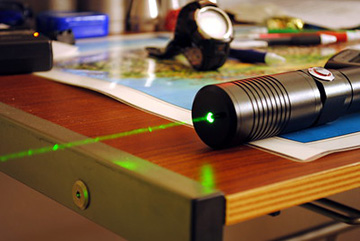
Byer says his favorite example of a laser invention is the green laser pointer, “because it came about from students asking questions in the classroom.” [Image: A. Adams/Flickr]
There are lots of stories that come out when we do basic research, or “discovery” research, as it is now called. You’re never quite sure where it’s going to go.
My favorite example, began in 1984, when two students asked me whether we could generate green light from a milliwatt diode-pumped infrared YAG laser. We challenged each other to think about it over the weekend. We came back to class on Tuesday and noted that if we put a nonlinear crystal inside of the laser cavity, we ought to be able to make a little laser pointer that converts 1 micron infrared light to green light.
So, the green laser pointer invention was written up and assigned to Stanford. The green laser pointer patent “matured” after 20 years in 2005. It was then that the market for green laser pointers took off.
So my favorite invention is the green laser pointer—because it came about from students asking questions in the classroom. It’s probably the most widely handheld laser in the world today. The power has gone from milliwatts to watts, so that you can buy a watt-level green laser pointer, which is kind of amazing.
So it goes well beyond just lighting up one’s PowerPoint presentation.
Yes—they’re widely used in many applications that I would have never imagined. One of the applications is as a rescue flare for sailors at sea. A green laser pointer and a battery pack that floats can be pointed up at the clouds overhead and put a green beam on the sky, so that a rescue helicopter can find you on the surface of the ocean.
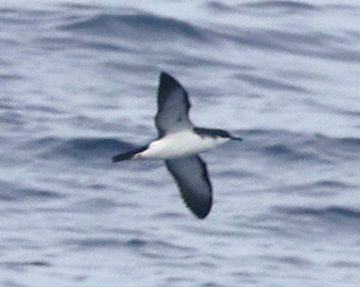
Among many other uses, Byer says, green laser pointers could light up powerlines to prevent collisions with a threatened Hawaiian bird, the Newell’s shearwater. [Image: Wikimedia Commons]
Another is saving birds. The Newell’s shearwater bird, on the Hawaiian island of Kauai, is at risk. These birds are injured or killed when they fly into high-tension wires and powerlines. Today, reflectors are placed along the powerline wires, and a green laser pointer on the telephone pole at each end illuminates the reflectors. The birds can make it safely to their nesting zone and the chicks can fly back out to sea when fledged.
These are things that come about that you never imagine will be reality. But they are reality, and they’re why the laser finds its use in a wide variety of applications.
